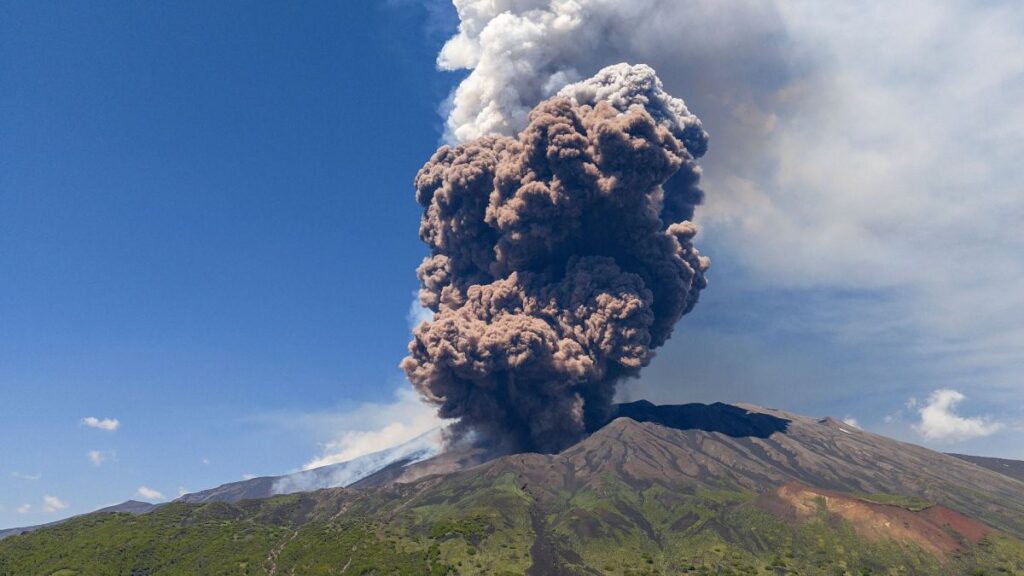By Euronews Travel
Published on •Updated
Mount Etna, the tallest and most active volcano in Europe, erupted earlier today, sending plumes of smoke into the air.
Dramatic video footage shared on social media showed tourists fleeing down the side of the mountain as a thick volcanic cloud intensified above them.
Italy’s National Institute of Geophysics and Volcanology (IGNV) said in a statement that the eruption began at 3:50 am local time following volcanic tremors that started at midnight. Volcanologists added that Mount Etna has been experiencing strombolian explosions of ‘growing intensity’. These explosions are typically a moderate kind of eruption.
A pyroclastic flow – an avalanche of hot rock, ash and gas – was seen on surveillance cameras at around 11:30 am local time. It was “probably produced by a collapse of material from the northern flank of the South-East Crater”, IGNV said.
This flow doesn’t appear to have crossed the edge of the Valle del Leone, a valley located at the foot of the summit craters on Mount Etna. But the explosive activity in the south-east crater has become a lava fountain, it added.
Mount Etna has a history of frequent eruptions dating back 3,000 years. It last erupted in February, sending a 3-kilometre river of lava flowing out of a crater called Bocca Nuova, meaning “new mouth”.
That eruption caused some minor disruption to travel, with parts of Catania airport closed due to reduced visibility.
Will flights be affected by the eruption and is Catania airport closed?
Catania airport stands at the foot of Mount Etna, giving departing and arriving passengers a spectacular view of the volcano.
Catania–Fontanarossa Airport, also known as Vincenzo Bellini Airport, on the island’s east coast, is Sicily’s most popular airport with international tourists.
The Volcanic Ash Advisory Centre in Toulouse, France, which monitors aviation risks, issued a red aviation warning earlier today. This has since been downgraded to an orange warning, and Catania Airport remains fully operational.
Departures are happening as scheduled, with just a few arrivals from Rome, Milan, and Berlin delayed this afternoon.
Passengers are still advised to check the status of their flight with their airline before leaving home, as volcanic activity can change the situation rapidly. You can also find updated information on arrivals and departures on the Catania Airport website.
Can I claim compensation if my flight is disrupted?
If flights at Catania Airport are disrupted, airlines are required to offer you another flight or a refund if a flight is cancelled or delayed by more than three hours.
However, this is only when they could have prevented the disruption. In the case of a volcanic eruption, it is not their fault.
But in most cases, airlines will still endeavour to get passengers to their final destination.
It’s always wise to have travel insurance as you may be able to claim back for unexpected expenses.
Is it safe to visit Sicily while Mount Etna is erupting?
Yes, it is still safe to travel to Sicily, even when Mount Etna is erupting.
Local authorities and residents are used to dealing with Mount Etna eruptions. For the last five years, it has erupted multiple times a year, and tourism to Sicily has been on the rise.
Despite frequent eruptions, lava has not reached nearby towns since the 1800s. Etna has more than 200 craters, and when one of these does erupt, black volcanic ash lands in the city of Catania at its foot and the many surrounding towns and villages.
This is inconvenient for residents, but usually not a problem for visitors. Some people even purposefully climb the volcano to see an eruption, though authorities urge tourists to keep a safe distance.
The mayor of Catania in Corriere della Sera has said that “everything is normal and under control”.
Read the full article here


